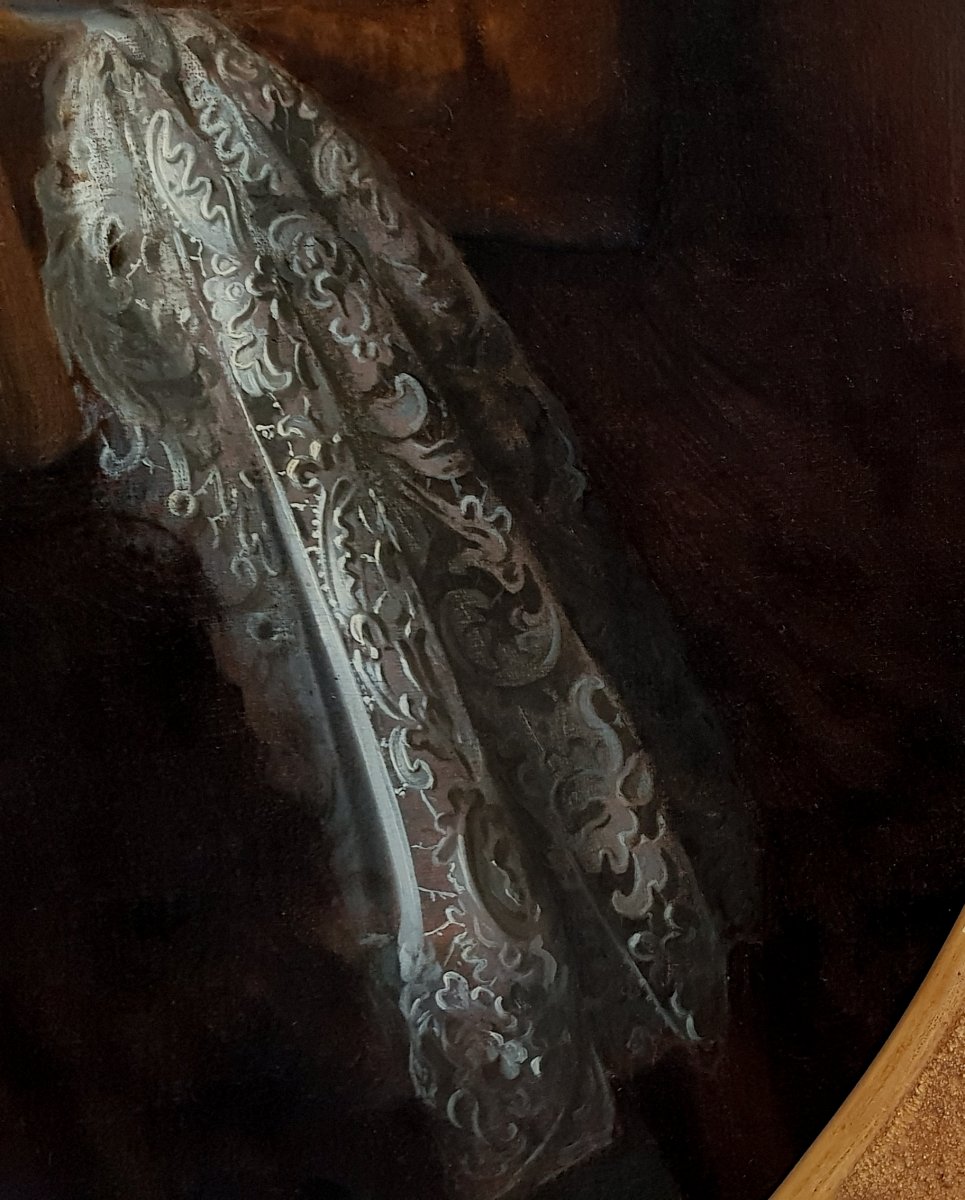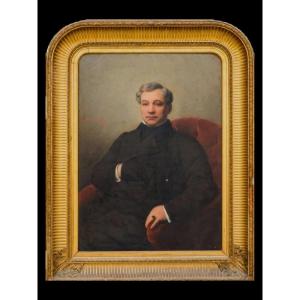The popularity of wigs was immense and this intensified the demand for them so much that natural hair became a valued commodity. Dealers in hair arose in all quarters and there are accounts in France that every peasant girl was trying to sell her hair. Unfortunately wig theft became common.
The delicate modelling of the face and the sophisticated handling of the garments, notably the cravat, is indicative of a talented artist who excelled at the oil technique of painting. Presented in a good quality gilded antique frame.
Provenance: The portrait has descended through the Coltée Ducarel family and Palmer Baronets for over 300 years:-
André (Andrew) Coltée Ducarel was born in Paris. His parents, Jacques Coltée Ducarel (1680-1718) and Jeanne Crommelin (1690-1723), were Huguenots from Normandy. Jacques was a banker and merchant, who achieved ennoblement in 1713 with the title Marquis de Chateau de Muids. He died in 1718, just as a new wave of Huguenot persecution was beginning, and in 1719 Jeanne fled with her three infant sons to England where they settled in Greenwich. There, Jeanne married her second husband, Jacques Girardot, another Huguenot. Andrew was sent to be educated at Eton and he later matriculated at Oxford from Trinity College, and graduated as a Bachelor of Civil Law. He was created Doctor of Civil Law in 1742 before being admitted a member of the College of Advocates at Doctors' Commons in 1743, and afterwards served as librarian there 1754-7, and as treasurer 1757-61. Ducarel was a fellow of the Society of Antiquaries of London, and he was one of the first fellows of the society on its incorporation in 1755. He was a fellow of the Royal Society of London. He was keeper of Lambeth Palace Library; a post that he remained in for nearly 30 years. He published a number of his own works. For many years Ducarel went on an antiquarian tour through different parts of the country, attended by a coachman and footman. They travelled about fifteen miles a day, and put up at inns. After dinner, Ducarel transcribed his topographical and archaeological notes. In 1752, he undertook a tour of Normandy and through his publications he effectively put Normandy on the map for the late 18th-century English traveller. He was one of the first Englishmen to see and appreciate the significance of the Bayeux Tapestry, and included the first detailed description in English as an appendix to Anglo-Norman Antiquities.
The work later passed to Sir Frederick Archdale Palmer, 6th Baronet Palmer (1857-1933). This branch of the Palmer Baronetcy, family seat Wanlip Hall in the County of Leicester, was created in 1791 for Charles Grave Hudson, a Director of the South Sea Company and High Sheriff of Leicestershire in 1784. Today, the heir apparent is Robert John Hudson Palmer (born 1960).
Nicolas de Largillierre was an importrant French artist who became one of Louis XIV's court artists. He learnt portraiture in Sir Peter Lely's London studio from 1675. He was the son of a hatmaker and merchant who moved with his family to Antwerp in 1659. At a very early age his artistic gifts were recognised and his father apprenticed him to Antoni Goubau (1616-1698). He was admitted to the painters' Guild of Saint Luke when he was only 17 and in 1675 he made a second trip to London, where he was employed at Windsor Castle (possibly at the suggestion of Peter Lely [1618-1680]) and worked as a restorer under the direction of Italian painter and decorator Antonio Verrio (c.1639-1707), who brought him to the attention of King Charles II (r. 1660-1685). In 1679 Largillierre settled in Paris. In 1686, Largillierre made another visit to England where he painted portraits of the newly crowned king, James II (r. 1685-1688) and his consort Mary of Modena (1658-1718). He was frequented by the aristocracy, the wealthiest echelons of society, and foreign dignitaries. In the course of his long career he amassed a large fortune and lived on a grand scale.
Measurements: Height 96cm, Width 83cm framed (Height 37.5”, Width 32.5” framed)























 Le Magazine de PROANTIC
Le Magazine de PROANTIC TRÉSORS Magazine
TRÉSORS Magazine Rivista Artiquariato
Rivista Artiquariato
